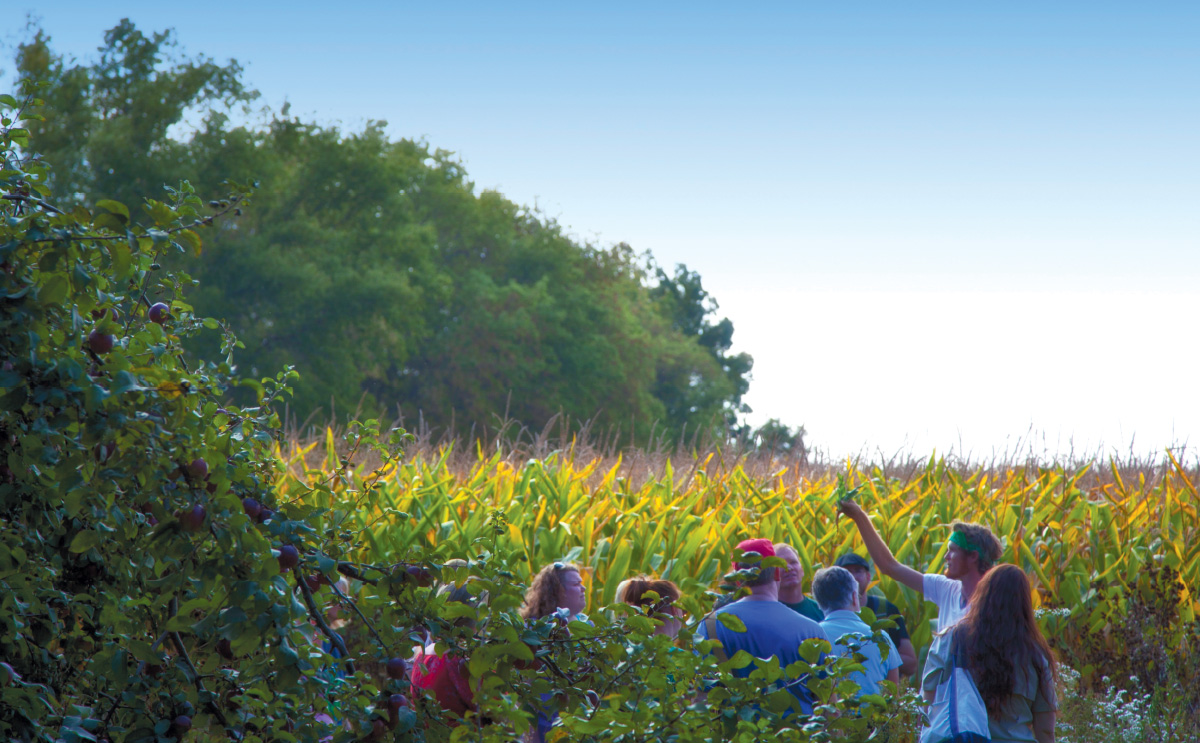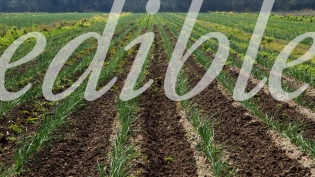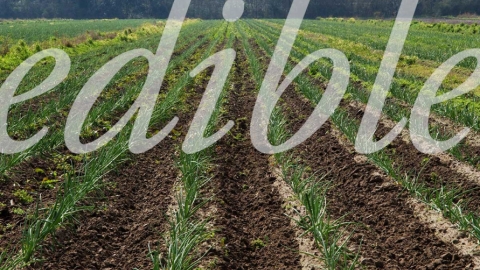Where the Wild Foods Are
I’m standing in the woods a mere 35 miles from my comfy Bay View home, hunting for wild nuts and berries for the first time, when the scene turns surreal.
Heath, our veteran foraging guide, takes a break from the dandelion leaves he’s munching and offers the group some nannyberries. I look around at my fellow foragers, waiting for Veruca Salt to cry out “Whoever heard of a nannyberry!?” But it’s clear we’re not in Wonka’s neck of the woods.
This is real. Nannyberries are real. And they taste, well, unreal — like an intense blueberry.
Until recently I reserved the word foraging for Pacific Northwesterners digging for razor clams and the tenacious cast members of Survivor. Then I tasted my first morel. Something about the mushroom’s complex woodsy flavor piqued my curiosity about what other (free) delicacies grow in Milwaukee’s surrounding woods.
I was about to get a second epiphany, this time expanding my wild palate well beyond morels.
At Wellspring Farm, wild edibles educator Heath Johnson led a dozen or so gatherers on a beginner’s edible plant walk. Standing tall and barefoot with a pitchfork in his left hand, knife strapped to his belt, Heath, a fellow thirtysomething, says he got a late start on foraging.
“Believe it or not, I didn’t start eating vegetables in earnest until I was in my twenties,” Heath confesses. After getting a psychology degree from Northern Illinois University, he worked as a public school special education assistant, all along harboring an interest in plants from a young age. Feeling the need to draw on his childhood passion, Heath left his school job “to get back to the natural world.” Organic farm internships seemed like the place to start, and “that’s where my interest in wild foods and foraging really took off.”
Nature’s Classroom
Wellspring Farm offers 36 acres of woods, ponds and prairies for Heath and other experts to teach curious minds the who’s who of the edible plant world. And like most teachers, he’s a stickler for the rules. After all, breaking them is not without its consequences.
When foraging in the wild, “one small detail can mean the difference between a tasty dinner and a trip to the emergency room,” he says, mostly joking. As long as you learn a few simple lessons, there’s nothing to fear. I quickly copied the rules into my assignment book like a good student.
Lesson 1: If you don’t know what it is, don’t eat it. Yes I actually wrote that down.
Lesson 2: Even if you think you know what it is, cross-reference with a field guide or expert. Ok, makes sense.
Lesson 3: Learn plant families, and be cautious if you have allergies to anything in that family. If you’re allergic to cashews, for example, it helps to know that sumac is in the same family. Who can’t relate to having irritations or reactions to family?
Lesson 4: Don’t pick your poison. Take a few minutes to learn what poisonous plants are in your area. Also keep in mind that while some parts of a plant may be edible if prepared correctly, other parts of the same plant may contain toxins. Pokeweed, for instance is harvested for its young shoots and berry juice, but the roots and seeds of the berries are considered toxic. Good thing I wrote down Lesson 1.
Lesson 5: When wild plants become famous, featured by high-end chefs or celebrated in the media for medicinal benefits, their sustainability is put in jeopardy. For example, the harvest and sale of wild ginseng, once common in parts of North America, is now regulated by the state of Wisconsin after being over-harvested to meet commercial demands. It’s good practice to leave some mature plants behind to produce fruits and seeds. Don’t be a selfish paparazzi forager.
Lesson 6: Take note of your surroundings. Is a plant growing alongside a commercial cornfield that’s been sprayed with pesticides? The same notion applies to wild edibles growing alongside a busy highway exposed to air pollution. Be cautious of the interstate hitchhikers.
Can we go foraging now? Hungry for more nannyberries and fully educated on the “don’ts,” we embark on our quest to learn the delicious dos. Not 10 yards from the picnic tables where we began we come across wild onions (Allium cernuum). Easily identified by their smell and long stalks, the pink and white cloves perched on top, called bulblets, taste like raw garlic. Really strong garlic. Wowee! Where are the mint plants?
Heath reaches down and pinches off the leaf of a common weed, one I often see in neglected yards and along the Oak Leaf Trail. He gives it a munch. “Weeds are the unsung heroes of the garden that have supported humans for thousands of years,” he touts. “This one tastes kind of earthy, like a mushroom, with a slight bitterness at the end,” he describes. “It’s called plantain (Plantago major). Notice how the leaves grow out and close to the ground. That’s called a basal rosette,” he explains. “Leaf patterns are an important characteristic to note when identifying a plant.”
Sure enough, we recognized this same pattern on the curly dock (Rumex crispus) neighboring the plantain. The leaves taste best in early spring before the flowers appear and again in fall when new leaves reappear. Much like spinach, the greens can be tossed in salads or sautéed in butter and garlic, or better yet, wild onion. I’m learning so much!
We head down to the pond for some roots. Heath’s on the hunt for cattails (Typha latifolia), and there’s plenty to go around. It’s the underground connecting roots that we’re after. The “laterals,” he calls them. “The pointy tips are the tender part,” he explains. “You can cook them like you would a potato.” The remaining part of the root can be boiled to make a starchy base or thickener for soups. “And see that brown hotdog looking thing on top of the cattail?” he asks. “Early in the season when they’re still green, you can remove the sheath and boil the spikes. I eat ‘em like corn on the cob... with butter. Yum.”
Foraging onward to sturdier ground, we come across a large tree with grayish-brown bark. “Oh, this is a real treat,” Heath announces as he picks up one of the golf ball-sized green orbs scattered about our feet. “This is a black walnut tree.” Known for their fragrance and rich, sharp flavor, black walnuts are added to salads, baked goods or made into nut butter... if you can get past the shell, that is. “Talk about a tough nut to crack,” he jokes. Removing the husk is not especially difficult but you’ll need a hammer or rock for the shell. If you think crab legs are a lot of work for not a lot of meat, don’t bother with these, unless they’re unshelled (and dipped in chocolate). Where are the nannyberries?
Around the corner, we’re excited to find wild apple trees, but my giddiness amplifies with a wild grape vine sighting in the distance (admittedly because I think they might be nannyberries). We’re just in time. In early fall, the grapes are sweet, juicy and acidic — a jam maker’s dream.
Next thing I know I’m face to face with the nannyberry shrub. How had I never heard of this before? It’s like the universe was teasing me all this time, keeping these gourmet gems tucked away in the woods. It’s almost as if they were singing out, “nanny, nanny ber-ry.” I recognize it right away with a sense of confidence. It has slender dark reddish-brown branches with leaves facing opposite each other. The berry is a blackish-bluish color, and its oval shape is a little tired looking, probably from all that teasing. Some commented that the large, flat seed was a nuisance to spit out, but I thought it added to the berry’s charm.
I was starting to understand the joys of foraging, and I remembered that in my attempt to uncover the wild delicacies of the woods, I had committed to another forage outing the following weekend.
The Hunt for High Bush Cranberries
Herbalist Linda Conroy and her partner at Moonwise Herbs, foraging expert John Holzwart, a.k.a “Little John,” are wrapping up a four-part wild plant series with an autumn workshop. I join a handful of students at the meeting point a few miles outside Sheboygan for an early-October harvest and feast.
We hike out with buckets, sacks and baskets in the hopes of finding high bush cranberries for sauce, wild grapes for juice, autumn olives for Linda’s catsup, and acorns, which she processes into flour for baked goods.
Trail snacks along the way include many familiar edibles from Heath’s excursion: crabapples, wild raisins, nannyberries, and wild grapes. But at this particular destination, much to everyone’s surprise, John spotted a row of hazelnut shrubs (Corylus Americana), or as I like to call them, Nutella trees. I started stuffing my pockets with the leafy husks, like a good little forager, until we put Lesson 5 into practice. Taking only a modest amount, we foraged on.
We cross a small stream and find our first high bush cranberry shrub. The berries are shiny and plump, like tiny red balloons ready to burst. Too sour to nibble on, we fill large sacks with the soon-to-be chutney and sauce before resting near the spring where Linda and John went on their first date.
The bulk of our afternoon is spent harvesting what has to be Wisconsin’s best-kept secret, the autumn olive (Elaeangus umbelata). Its sweet-tart, candy-licious berries resemble small-scale red Jelly Bellies with silver speckles. It was love at first taste. “Do you think you would recognize this shrub without its berries?” Linda asks me. Nope. “Notice the leaves. They’re bright green above and silver below. And the same speckled pattern that’s on the berries is present along the stem.”
As I continue racking berries, I pay close attention to the plant, noting its leaf pattern, shape and colors. I must have looked lost in the moment of getting to know the shrub, prompting Linda to offer Lesson 7. “When you’re out here, try to experience a timeless moment.”
I paused to let her words sink in, and just like that, it was time to go.
The Feast
Linda and John welcome us into their home, where our foraged finds supplement venison hunted by John and wild rice the couple harvested earlier in the season. We snack on pickled cornelian cherries while we chop oyster mushrooms from the yard and broil puffball mushroom steaks. John takes the nannyberries out back to process into a buttery spread before transforming the high bush cranberries into a rich sauce used to drizzle over homemade paneer cheese. For Linda’s acorn muffins, there’s crabapple chutney and pear sauce. And to drink, John’s very own “Dandydog,” a hot beverage made from roasted and ground dandelion root and cornelian cherry seeds.
But before we indulge in these bountiful offerings, we gather in a circle, hold hands and sing, giving thanks to the Earth. I leave feeling warm and full and somehow connected to my ancestors and the land in a way that feels natural and real and, perhaps more than anything, timeless.






